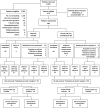Three-year follow-up of a randomised clinical trial of intravenous versus oral iron for anaemia in pregnancy
- PMID: 23087011
- PMCID: PMC3488743
- DOI: 10.1136/bmjopen-2012-000998
Three-year follow-up of a randomised clinical trial of intravenous versus oral iron for anaemia in pregnancy
Abstract
Background: To date, there are no data available concerning the impact of iron therapy on the long-term well-being and health-related quality of life (HRQoL) in pregnancy.
Objective: To assess the long-term effect of iron therapy on HRQoL in pregnancy.
Design: This is a follow-up study conducted between January 2010 and January 2011 of an earlier randomised open-label clinical trial of intravenous and oral iron versus oral iron for pregnancy-related iron deficiency anaemia. We used a modified version of the SF-36 questionnaire together with the original prospective HRQoL data collected during and after pregnancy.
Participants and interventions: Of the original evaluable 183 pregnant Caucasian women randomised to receive oral iron or a single intravenous iron polymaltose infusion followed by oral iron maintenance, 126 women completed the follow-up HRQoL study.
Methods: The participants were followed up 4 weeks after treatment, predelivery and postdelivery for a median period of 32 months (range, 26-42) with a well-being and HRQoL questionnaire using a modified SF-36 QoL-survey and child growth charts as set by the Australasian Paediatric Endocrine Group (APEG).
Results: Patients who received intravenous iron demonstrated significantly higher haemoglobin and serum ferritin levels (p<0.001). There were strong associations between iron status and a number of the HRQoL parameters, with improved general health (p<0.001), improved vitality (physical energy) (p<0.001), less psychological downheartedness (p=0.005), less clinical depression (p=0.003) and overall improved mental health (p<0.001). The duration of breastfeeding was longer (p=0.046) in the intravenous iron group. The babies born in both groups recorded similarly on APEG growth chart assessments.
Conclusions: Our data suggest that HRQoL is improved until after pregnancy in anaemic pregnant women by repletion of their iron stores during pregnancy. About 80% of the intravenous iron group showed a maintained normal ferritin until delivery with long-term benefits. Further studies to confirm these findings are warranted.
Figures



References
-
- Allen L. Multiple micronutrients in pregnancy and lactation: an overview. Am J Clin Nutr 2005;81:1206S–12S - PubMed
-
- Bashiri A, Burstein E, Sheiner E, et al. Anemia during pregnancy and treatment with intravenous iron: review of the literature. Eur J Obstet Gynecol Reprod Biol 2003;110:2–7 - PubMed
-
- Beard J. Effectiveness and strategies of iron supplementation during pregnancy. Am J Clin Nutr 2000;71:1288S–94S - PubMed
-
- Allen L. Anemia and iron deficiency: effects on pregnancy outcome. Am J Clin Nutr 2000;71:1280S–4S - PubMed
-
- Scholl TO, Reilly T. Anemia, iron and pregnancy outcome. J Nutr 2000;130:443S–7S - PubMed
LinkOut - more resources
Full Text Sources
Medical
